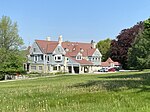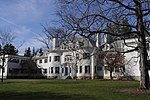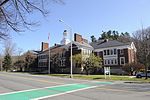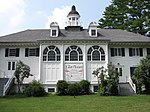Naumkeag
1880s architecture in the United States1958 establishments in MassachusettsChoate familyGardens in MassachusettsGilded Age ... and 16 more
Gilded Age mansionsHistoric districts on the National Register of Historic Places in MassachusettsHistoric house museums in MassachusettsHouses completed in 1887Houses on the National Register of Historic Places in Berkshire County, MassachusettsLandscape design history of the United StatesMcKim, Mead & White buildingsMuseums in Stockbridge, MassachusettsNRHP infobox with nocatNational Historic Landmarks in MassachusettsProtected areas established in 1958Shingle Style architecture in MassachusettsShingle Style housesStockbridge, MassachusettsThe Trustees of ReservationsUse mdy dates from August 2023

Naumkeag is the former country estate of noted New York City lawyer Joseph Hodges Choate and Caroline Dutcher Sterling Choate, located at 5 Prospect Hill Road, Stockbridge, Massachusetts. The estate's centerpiece is a 44-room, Shingle Style country house designed principally by Stanford White of McKim, Mead & White, and constructed in 1885 and 1886. The estate is noted for its large gardens, which were designed in the mid-20th century by noted landscape designer Fletcher Steele in conjunction with Mabel Choate. A National Historic Landmark District, Naumkeag is now owned by The Trustees of Reservations, who operate it as a nonprofit museum.
Excerpt from the Wikipedia article Naumkeag (License: CC BY-SA 3.0, Authors, Images).Naumkeag
Sergeant Street,
Geographical coordinates (GPS) Address Website External links Nearby Places Show on map
Geographical coordinates (GPS)
| Latitude | Longitude |
|---|---|
| N 42.289694444444 ° | E -73.315861111111 ° |
Address
Naumkeag Garden
Sergeant Street
01263
Massachusetts, United States
Open on Google Maps










